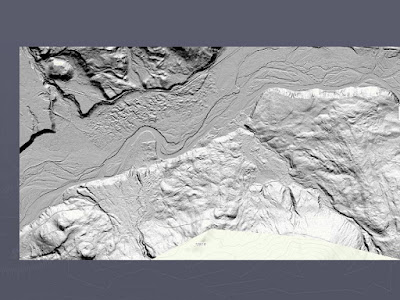Geology is very often a study of deep history. The more recent geology history intersects human history. In doing some research on one bit of recent geology history, I came across this map which had some other geology/human history that distracted me for a bit..
The map shows a survey of an area along the Skagit River across from present day Hamilton (Hamilton has had some troubles with the Skagit River flooding and channel movement).
I was vaguely aware of coal diggings which are shown on the map. The Coal Mine Hotel shown on the map is long gone - likely taken out by the river a long time ago.
To the east of the coal mining area are a couple of mapped mining claims on the survey map. These claims are in a completely different geologic formation that would not include any coal - the Shucksan Greenschist, an ocean floor unit that was accreted onto the North American margin. During accretion, these ocean floor rocks were deeply buried in the subduction zone along the edge of North America and were metamorphosed under very high pressures, but remarkably relatively low temperatures.
The mining claims were for iron mining. Hill and Melrose (1940) provide a description of the iron ore district near Hamilton and note that the ore was shipped to Irondale (its-called-ironddale-for-reason).
The mountain slope upon where the claims are located is aptly named Iron Mountain. The mining activity was fairly short lived as far superior deposits and other logistics of the steel industry shifted the fortunes of the this mining district.
The Skagit River Journal (http://www.skagitriverjournal.com/), a wonderful history source for the Skagit County area, noted that there were issues with mining claim registrations which hurt the district.
The geology of the iron deposits is very complex with lots of faults and discontinuities. Owen (1988) provides a detailed description of these iron deposits in a University of Washington thesis titled The petrogensis of blueschist facies ironstones in the Shucksan and Easton Schists, North Cascades, Washington. The geology and geochemistry of Iron Mountain can be a bit daunting with some fairly unique and rare mineral assemblages.
I took a look at the 1950s aerial photograph of the mine claim area to see if there was any evidence of mining.
Nothing was evident at these claims, but plenty of logging roads and landslide scars. And note the sediment clogged stream coming off of Iron Mountain.
1890s Government Land Office Survey
The map shows a survey of an area along the Skagit River across from present day Hamilton (Hamilton has had some troubles with the Skagit River flooding and channel movement).
I was vaguely aware of coal diggings which are shown on the map. The Coal Mine Hotel shown on the map is long gone - likely taken out by the river a long time ago.
To the east of the coal mining area are a couple of mapped mining claims on the survey map. These claims are in a completely different geologic formation that would not include any coal - the Shucksan Greenschist, an ocean floor unit that was accreted onto the North American margin. During accretion, these ocean floor rocks were deeply buried in the subduction zone along the edge of North America and were metamorphosed under very high pressures, but remarkably relatively low temperatures.
The mining claims were for iron mining. Hill and Melrose (1940) provide a description of the iron ore district near Hamilton and note that the ore was shipped to Irondale (its-called-ironddale-for-reason).
The mountain slope upon where the claims are located is aptly named Iron Mountain. The mining activity was fairly short lived as far superior deposits and other logistics of the steel industry shifted the fortunes of the this mining district.
The Skagit River Journal (http://www.skagitriverjournal.com/), a wonderful history source for the Skagit County area, noted that there were issues with mining claim registrations which hurt the district.
The geology of the iron deposits is very complex with lots of faults and discontinuities. Owen (1988) provides a detailed description of these iron deposits in a University of Washington thesis titled The petrogensis of blueschist facies ironstones in the Shucksan and Easton Schists, North Cascades, Washington. The geology and geochemistry of Iron Mountain can be a bit daunting with some fairly unique and rare mineral assemblages.
I took a look at the 1950s aerial photograph of the mine claim area to see if there was any evidence of mining.
Nothing was evident at these claims, but plenty of logging roads and landslide scars. And note the sediment clogged stream coming off of Iron Mountain.



















































